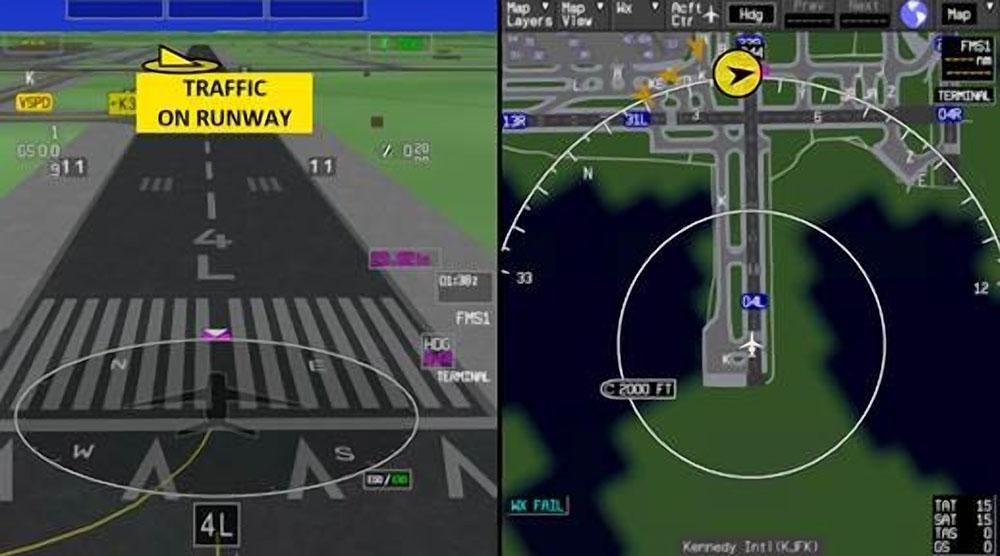
Honeywell Aerospace Technologies is developing a runway incursion/collision avoidance system designed to mitigate the risk of a pilot landing on or taking off from an occupied runway.
The system, which Honeywell refers to as Surf-A (Runway Surface Alerts), is aimed at commercial and business aircraft retrofit, which are its principal markets, according to Thea Feyereisen, a Honeywell Aerospace Technologies senior fellow. She notes that, for forward fit on aircraft with more capable displays, the planned primary offering will be Surf-1A which includes integrated graphical encoding of traffic on an airport moving map display, along with runway traffic alerts.
“While we do not have an estimate of the size of the retrofit and forward fit markets, we believe that all air transport and business aircraft should be equipped with this safety technology, which is just as important as TCAS (traffic alert and collision avoidance system) and EGPWS (enhanced ground proximity warning system),” says Feyereisen.
According to Feyereisen, Surf-A and Surf-1A generate simultaneous aural and text messages—displayed on the EGPWS/NAV or EGPWS on more modern aircraft—to alert flight crews of an impending runway collision if their aircraft is on a predicted collision course within the next 30 sec. This requires knowledge of own-ship position, accelerations, phase of flight, threat algorithms and other-ship ADS-B In traffic information, along with a high integrity updateable runway database, as well as advanced algorithms to detect a collision risk on the runway of own-ship operations.
“Surf-A algorithms can detect (possible) runway collisions between two aircraft on the ground, or own-ship ground/other-ship airborne,” she says. “In addition, Surf-A looks for intersecting runway operations in which one runway is used for takeoff and the other for landing. We have seen some recent near misses there.”
Surf-A is a software upgrade to Honeywell’s MK V-A EGPWS, which was introduced in 2013. Feyereisen says the EGPWS is capable of hosting Surf-A in tandem with Honeywell’s Smart-X, a runway situational awareness software product. While recommended, Smart-X is not required.
“The Surf-A core function is portable to other (capable) platforms, although some additional work will be required for compatibility and integration of the alert function,” Feyereisen says. The other platforms, she adds, do not include the EGPWS MK V. Rolled out in 1996, MK V is capable of hosting limited runway awareness and advisory system Smart-X functions, but not Surf-A.
According to Feyereisen, an MKV-A Surf-A retrofit is on-wing loadable, with an anticipated aircraft down time of less than 10 hr. for installation. Wiring in the form of a twisted pair will be needed to connect the aircraft’s traffic computer and EGPWS MKV-A, which she notes are typically located a few feet apart within the same avionics bay.
The first operational trials began in 2010 under an FAA contract, using the MKV as the host platform for the initial threat algorithms. Feryereisen says Honeywell conducted major flight test campaigns between 2010-24 using a variety of commercial and business airframes, including a Beechcraft King Air, Dassault Falcon 900, Embraer 170 and Boeing 757. She points out that entry into the market will be on the MKV-A, since the older MKV does not have the room to host Surf-A’s latest features, brought about by subsequent software upgrades.
Honeywell is aiming for Surf-A certification by early 2026. Since this will be the first certification of a safety feature specifically for runway incursions, Feyereisen stresses that there are no companion FAA advisory circulars or regulations, minimum aviation system performance standards or minimum operational performance standards—and no equivalent document exists in Europe.
“With the lack of clear regulatory guidance, certification of the non-technical standards order function will [be] based upon issue paper from FAA and/or the European Union Aviation Safety Agency." Feyereisen notes. “We do need to account for time in our schedule to address ambiguity in definition of artifacts, performance and testing requirements from the regulators. Still, we have a path forward identified for certification, based upon our knowledge of the criticality of the identified intended function, and similarity to other runway safety functions, like Smart-X.”





